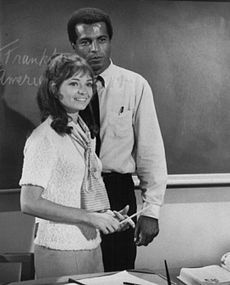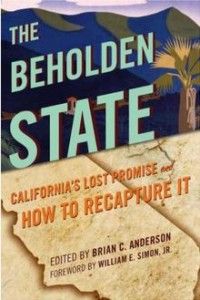Book describes CA problems, how to fix them: Part 2

Look for the Union Label
Political power is government power. And no political power in California is greater than that of the public-employee unions. Statewide, the California Teachers’ Association is the most powerful force. But the largest local union in the state is the United Teachers of Los Angeles, whose members are affiliated with both with the CTA and the California Federation of Teachers.
 Ben Boychuk, the associate editor of City Journal and a columnist for the Sacrament Bee, dissects UTLA power. His chapter is, “The Union’s Occupation: United Teachers of Los Angeles Wages Its Own War on ‘The 1 percent.'” It begins on the book’s page 222, a coincidental echo of “Room 222,” a 1969-74 TV series I used to watch when I was a teenager about a classroom in the LAUSD, featuring cute Karen Valentine. That was back when California schools ranked among the best in the nation, instead of near the bottom today.
Ben Boychuk, the associate editor of City Journal and a columnist for the Sacrament Bee, dissects UTLA power. His chapter is, “The Union’s Occupation: United Teachers of Los Angeles Wages Its Own War on ‘The 1 percent.'” It begins on the book’s page 222, a coincidental echo of “Room 222,” a 1969-74 TV series I used to watch when I was a teenager about a classroom in the LAUSD, featuring cute Karen Valentine. That was back when California schools ranked among the best in the nation, instead of near the bottom today.
He reports on the close affinity between the union and the Occupy Movement. In particular, he analyzes the October 2011 Occupy LAUSD protest, which included about 500 teachers involved in the Occupy Movement. The protest demanded, he writess, “more money, more teachers, and less student testing.” But there wasn’t anything new about the demands. “They are precisely the same demands that the UTLA has made for months.” They especially were objecting to how Eli Broad, Bill Gates and others of the “1 percent” were pushing charter-school reform on the LAUSD.
However, as Boychuk notes, the billionaires “are hardly the prime movers or the last word on education reform — a point that UTLA and its left-wing union allies refuse to concede.” The real locus of education reform is parents fed up with their kids’ substandard educations. The current system — especially the LAUSD/UTLA — especially harms poor and minority children, who are stuck in dysfunctional schools designed to advance bureaucratic and union goals rather than prepare kids for a high-tech economy.
Thus, the Occupy LAUSD movement, rather than being a radical protest designed to promote great education for the future, in Boychuk’s analysis is “reactionary,” perpetuating the failed model of “tax-funded schools operated by union-organized administrators and teachers with little testing and accountability and no choice.”
Hope for Reform
Is there hope for California? Certainly. The book includes some ways out. Boychuk writes in the “Triggering Reform” chapter about the 2010 “trigger” law, which allows the majority of parents in a school to vote to “trigger” the replacement of a failing administration. He details the ordeal parents at Desert Trails Elementary school went through against an intransigent Adelanto School District. Fed up with their school’s poor performance, the parents pulled the “trigger.” In 2012, the parents won a court case, and in 2013, the district “approved the Desert Trails charter plan,” creating a charter school more responsive to parents and students.
Since then, two “triggers” have been pulled at LAUSD schools. More “triggers” are likely to be pulled across the state in the future.
Tax reform?
Arthur Laffer heads the Laffer Center at the Pacific Research Institute, CalWatchDog.com’s parent think tank. He helped design Proposition 13, California’s landmark 1978 tax cut initiative. His chapter in the book is, “Flatten Taxes!”
He writes how, on Jan. 5, 2006, he decide to leave California, taking his Laffer Associates firm with him, for the green pastures and twanging guitars of Nashville, Tenn., and no state income taxes. On that day, Gov. Arnold Schwarzenegger, having failed to pass four reform measures the previous November to rein in state spending, gave a State of the State Address calling for massive new government programs.
“I was utterly aghast,” Laffer writes, as Schwarzenegger “resolved to move in a big-government direction, making proposals that included issuing billions of dollars’ worth of new bonds to pay for statewide infrastructure projects. The last thing California needed was more spending. It was time for me to go.”
Laffer writes about the many other firms that have left the state. But he has a solution: a flat tax for the state of 6 percent, applied on all income. All other state taxes would be eliminated. The reform would be revenue-neutral: it would bring in the same amount as the current system, so government would not have to be cut.
But it would free the state from the confiscatory, progressive income and capital gains taxes that currently encumber business and jobs creation. Sure, Twitter, Facebook, Apple, etc., don’t care much about tax rates. They’re the digerati elite. But an absurd tax system affects the rest of us.
With California seeming to be “back,” as Gov. Jerry Brown keeps insisting, Laffer’s reform is stalled. The time to bring it forward will be during the next big recession, when tax revenues plunge because the state so foolishly relies on rich people paying so much. When stocks crash, so do rich people’s incomes and stock gains, also crashing state revenues, as happened happens every business cycle, creating the infamous deficits that shock everyone. Such as the $40 billion state budget deficit of the dot-com bust in 2000-01.
So, there is hope for California. Maybe a flat tax reform will be enough to lure Dr. Laffer back to the surf.
Related Articles
Contra Costa supervisors paid twice for vehicle costs
Some members of the Contra Costa County Board of Supervisors are facing sharp questions about their ethics and honesty over
Gov. Brown goes back to school
Oct. 29, 2012 Katy Grimes: Some say that Gov. Jerry Brown is getting schooled on Proposition 30. Others say he’s
Sacto Kings players dream of no-tax state
April 19, 2013 By Katy Grimes As the behind-the-scene negotiations take place between the NBA, the owners of the Sacramento




